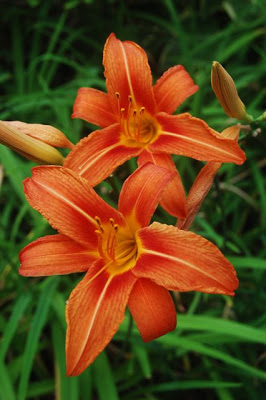Who doesn’t want a garden that’s low maintenance? Of course, the mantra is: Low maintenance does not mean no maintenance. Even if you’re laying down concrete grass and planting plastic flowers, some maintenance will be required.
However, selecting well will help you keep plant maintenance to a minimum. If you don’t want to spend your life watering, feeding, propping up, chopping down or replanting, here are some things to think about:
 • Know thyself. Know how much you have to put into your garden. Short on time? Don’t select plants that need special attention, such as dahlias that must be lifted in fall and stored over winter… unless you want to treat them like annuals. Or irises that require regular division. And avoid fast-growing trees such as the weeping mulberry which must be pruned yearly to look their best.
• Know thyself. Know how much you have to put into your garden. Short on time? Don’t select plants that need special attention, such as dahlias that must be lifted in fall and stored over winter… unless you want to treat them like annuals. Or irises that require regular division. And avoid fast-growing trees such as the weeping mulberry which must be pruned yearly to look their best.
• Select plants that will thrive in your zone. The Greater Toronto Area spans from Canadian Zone 6A (and, in some sheltered areas, 6B) down by the lake to Zone 5 in the 905 area. (Those numbers look a full zone higher than in the U.S. zone system, which puts us between Zones 5 and 4. We explained why last year in this post.) If it’s a borderline-tender plant in your zone, you’ll spend a lot of time babying it through the cold.
• Select plants that like your garden’s growing conditions. Know your garden: is it sun or shade, moist or dry, is it sand, clay, loam or in between? Moisture lovers will need watering, more so if your garden is dry. Plants that are heavy feeders will need feeding if your garden’s on sand. Pick plants that thrive on what you have to give.
• Select the right-size plant for your space. If your garden is small, choose small or dwarf varieties of larger plants such as shrubs and trees. No sense having a tree that has to be pruned, lopped or (shudder) topped to stay within bounds. Actually measure your garden, and some of the larger objects in it, to get a clear sense of how much room you have. If you love a certain shrub, ask if there’s a compact version of it. If it exists, hold off till you find it.
• Know how your plant reproduces. Is it a vigorous underground spreader such as goutweed or lily of the valley? Is it a rampant self-seeder such as Norway maple. Avoid, unless you like deadheading or weeding. Or at least, know how much you’re willing to tolerate. For grasses or daylilies, look for key-words like “clump forming” which tells you they’re well behaved.
• Know how long your plant will live. Often when people choose perennials over annuals it’s because they assume that perennials live forever. Not so. The difference is all about seeds. Annuals have a lifecycle of one year. That is, they germinate, produce seed and then die within a single year. Biennials take two years to do this, germinating the first year and producing seed the next.
Perennials take longer to mature and produce flowers and seed, but compensate by flowering for more s
easons. Not forever, though. As they’ve already lived a season or two at the nursery, some may last only a few years in your garden. That gaillardia you selected because knocks itself out blooming may do just th
at, and soon need replacing. That’s a lot of work, especially if you’ve planted such plants in mass.
These are a few thoughts to get you started. For the last two points particularly, I really must acknowledge Michelle Reid and her great Ryerson course the Art and Management of Planting Design. You’ll hear more about that in posts to come.







9 comments
Great advice!
I wish I read this ten years ago. It cost me a lot of time and money to learn.
Great advice, Helen. So many of us try to push the zone and plant things that are not always hardy enough. Geum for example – tried it many times and it never made it through my Oshawa winter.
These are great pointers, Helen. I love getting the second-hand fruits of your courses! 🙂 -Jean
I enjoyed your post, Helen. Thank goodness I can move plants around! 🙂
Loved the post~~When I began gardening I just bought plants and planted them directly into the ground~They died! It took me years to figure out how to garden…but am I ever glad I stuck with it. gail
Some very good tips Helen! The hardest one I think is to know how long your plants will live. Those that bloom out so fast could make it 3 years but may be more or less. That's why I make the cuttings – insurance!
Good post Helen!
Helen,
Answer to your question: it's fair to say that I'm on total overload maintaining both blogs along with demands of my garden!
xo
Alice